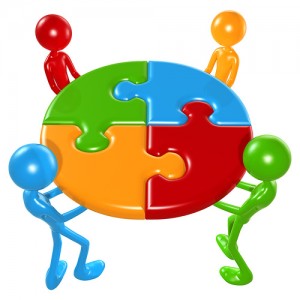
 Over the past few weeks I’ve had more and more clients ask me the same question: How can we learn from Facebook and Twitter to improve internal collaboration? I’ve been reflecting on this and have tried to translate some of our best loved social networking features into design patterns for consideration when building a collaborative intranet environment.
Over the past few weeks I’ve had more and more clients ask me the same question: How can we learn from Facebook and Twitter to improve internal collaboration? I’ve been reflecting on this and have tried to translate some of our best loved social networking features into design patterns for consideration when building a collaborative intranet environment.
In this post I’ll look at some of the natural collaborative behaviours that occur in the workplace and briefly consider how to design services for them.
(1) People naturally gather around common points of interest
Projects, clients, work teams, specific assignments, specific contracts, sporting and social events — these are all natural points of interest. In our office environments there are various mechanisms which encourage or enforce us to work together and, in doing so, we’ll meet, talk and share our thinking. On Facebook these points of interest become groups or events, on Twitter they become trending hashtags. Depending on the richness of the website, these web workspaces can contain blogs, wikis, media sharing, calendars, etc.
(2) People like visuals
Facebook showed us the power of the profile pic and the photo album from the very beginning. LinkedIn finally caught on in 2007. Even Twitter — the king of text — recognises the power of a profile pic to quickly associate a tweet with a person. It’s only human that we naturally tend to find pictures more engaging than reams of text. In the workplace, particularly larger ones where often colleagues may not have met each other, this is an important way of visually separating the relevant from the irrelevant.
(3) People are increasingly able to use complex websites
Somehow, Amazon, eBay and the BBC have managed to make it intuitive to run through complex transactions and/or interpret incredibly large amounts of information. When designing for your intranet, use common design patterns that people are familiar with and recognise. Design for intuitiveness — develop user journeys around common transactions and work with users to model how they would work on the new platform. A service that is well used is more value than one with a quirky or funky design look.
(4) People want to be able to add their own content
One of the reasons the iPod trounced other MP3 players in the market was because it was the easiest to load up with music from your PC. It’s an important lesson — the more people can self-serve, the more they will self-serve. If you want to thwart people’s usage of your collaboration tools — make it so they have to request your IT function to create a new group, to post a blog entry or to upload some photos. That’ll stop ’em every time.
(5) Different people have different styles of working together
For most people, working with other people is rewarding. Your intranet should make it easy to be in touch with people. Embed presence information across the site. Provide one click access to multiple contact channels (email, phone, IM, broadcast messaging, etc.) Recognise that different work groups will fall into different patterns — some might use email, others will prefer message boards and wikis. That’s okay, as long as there are enough options to enable every group of people to work productively.
(6) Information that is not found might as well not be published
In the “old days”, we used structured hierarchies and predetermined taxonomies to organise information but the reality is, people don’t think that way. Folksonomies, user defined tags and Google inpsired index driven search are the design patterns we’ve come to expect. Sure, it’s chaotic and feels out of control but so is the web and somehow, on Google and flickr, we find what we want.
(7) Workplaces are full of real-time, short interactions
Conversations on profile walls are the watercooler chats of the web. Statuses are the way you tell a global team what you’re working on. Broadcast messaging (Twitter style) is the way you tap into a massive knowledge network that could be at the next desk or on the next continent. Intranet services that provide a blend of these features in a truly integrated fashion give people the richness of Facebook, Twitter and IM in a single collaborative environment. If it is hosted within your corporate network you can apply enterprise search (within reason) and meet your regulatory commitments. In many ways, this is the “Google Wave vision”.
Study after study shows that an organisation that makes better use of its knowledge resources and collaborates better will deliver better results. Software vendors are beginning to recognise this and newer versions of collaboration software are taking these lessons into their functional designs. Intranets which disseminated information from the centre are no longer enough to meet user expectations around collaborative platforms. Interpreting and applying design patterns from social networking services can help us design compelling and widely adopted intranets.
[Image credit: rama_miguel, via flickr]
Get the TNW newsletter
Get the most important tech news in your inbox each week.





